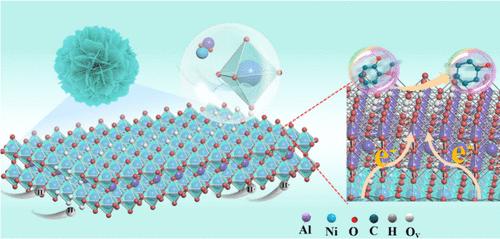Defect Engineering-Regulated Electron Transfer of NiAl-MMO for Catalyzing Directed Conversion of Lignin into Cyclohexanol-Based Chemicals
IF 7.3
1区 化学
Q1 CHEMISTRY, MULTIDISCIPLINARY
引用次数: 0
Abstract
Regulating electron transfer through defect engineering to selectively catalyze the cleavage of lignin C–O bonds is of significant scientific importance for the directed conversion of biomass into high-value chemicals. However, the precise dissociation of chemical bonds remains challenging. In this study, a 2D nanoflower-like NiAl-MMO catalyst was successfully constructed via a hydrothermal in situ pyrolysis synergistic strategy. An Al doping strategy was employed to fabricate Ni and Al3+-Ov (Ov denotes oxygen vacancy) synergistic dual active centers in NiAl-MMO. The research results indicate that the introduction of Al significantly enhances the catalytic performance. When an appropriate amount of Al is doped, it not only effectively increases the specific surface area of the catalyst and optimizes its pore structure but also enables the formation of moderate-strength interactions between metallic Ni and Al. Meanwhile, the presence of Al induces an increase in the concentration of Ov in the catalyst. Ov can regulate the electronic state of Ni active sites by modulating electron density while also enhancing the Lewis acidity of the catalyst, thereby improving its adsorption capacity for reactants. This electronic regulation optimized the electronic coupling environment of bimetallic sites and significantly strengthened the synergistic effect between Al3+-Ov and Ni sites, improving the hydrogen activation capability and directed C–O bond cleavage performance of the catalytic system. The catalyst exhibited excellent C–O bond dissociation selectivity in the lignin hydrodeoxygenation (HDO) process with a total liquid yield of 45.7 wt % (68.4% selectivity for C6+ cyclohexanol), providing a new approach for the synthesis of aviation fuel precursors. This work offers a novel strategy for the directed conversion of lignin through the synergistic regulation of interfacial defects and electronic structures.

缺陷工程调控NiAl-MMO催化木质素定向转化为环己醇基化学品的电子转移
通过缺陷工程调控电子转移,选择性催化木质素C-O键的裂解,对于生物质定向转化为高价值化学品具有重要的科学意义。然而,化学键的精确解离仍然具有挑战性。在本研究中,通过水热原位热解协同策略,成功构建了二维纳米花状NiAl-MMO催化剂。采用Al掺杂策略在NiAl-MMO中制备了Ni和Al3+-Ov (Ov为氧空位)协同双活性中心。研究结果表明,Al的引入显著提高了催化剂的催化性能。当适量的Al掺杂时,不仅有效地增加了催化剂的比表面积,优化了催化剂的孔隙结构,而且使金属Ni与Al之间形成了中等强度的相互作用。同时,Al的存在导致催化剂中Ov浓度的增加。Ov可以通过调节电子密度来调节Ni活性位点的电子态,同时提高催化剂的Lewis酸度,从而提高其对反应物的吸附能力。这种电子调控优化了双金属位点的电子耦合环境,显著增强了Al3+-Ov和Ni位点之间的协同效应,提高了催化体系的氢活化能力和定向C-O键裂解性能。该催化剂在木质素加氢脱氧(HDO)过程中具有良好的C-O键解离选择性,总产液率为45.7 wt % (C6+环己醇选择性为68.4%),为航空燃料前驱体的合成提供了新的途径。这项工作为通过界面缺陷和电子结构的协同调节木质素的定向转化提供了一种新的策略。
本文章由计算机程序翻译,如有差异,请以英文原文为准。
求助全文
约1分钟内获得全文
求助全文
来源期刊

ACS Sustainable Chemistry & Engineering
CHEMISTRY, MULTIDISCIPLINARY-ENGINEERING, CHEMICAL
CiteScore
13.80
自引率
4.80%
发文量
1470
审稿时长
1.7 months
期刊介绍:
ACS Sustainable Chemistry & Engineering is a prestigious weekly peer-reviewed scientific journal published by the American Chemical Society. Dedicated to advancing the principles of green chemistry and green engineering, it covers a wide array of research topics including green chemistry, green engineering, biomass, alternative energy, and life cycle assessment.
The journal welcomes submissions in various formats, including Letters, Articles, Features, and Perspectives (Reviews), that address the challenges of sustainability in the chemical enterprise and contribute to the advancement of sustainable practices. Join us in shaping the future of sustainable chemistry and engineering.
 求助内容:
求助内容: 应助结果提醒方式:
应助结果提醒方式:


